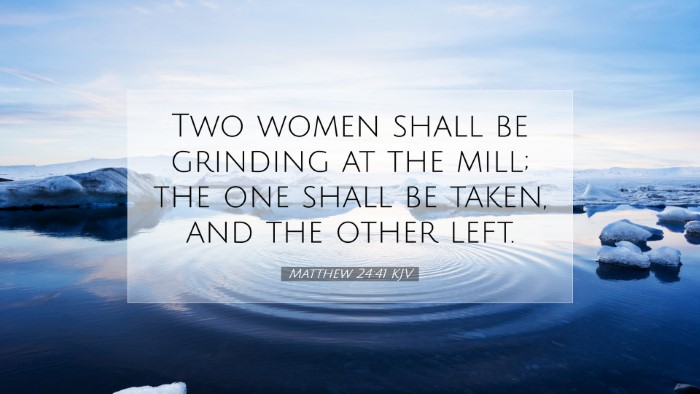Commentary on Matthew 24:41
Verse: "Two women will be grinding at the mill; one will be taken and the other left." - Matthew 24:41
Context of Matthew 24
Matthew 24 is often viewed as the Olivet Discourse where Jesus speaks about the end times, the destruction of the temple, and the signs of His coming. It reflects both warnings and assurances, indicating a dual importance of preparedness and vigilance.
Analysis of the Verse
The imagery in Matthew 24:41 provides insight into the relationships and distinctions between people at the time of judgment. The setting of two women grinding at the mill signifies the ordinary aspects of daily life, revealing that divine interventions occur amidst the mundane.
1. Symbolism of Daily Life
The act of grinding at the mill represents typical human activity. Commentators like Matthew Henry emphasize that judgment can come unexpectedly amidst daily routines. The ordinary life does not exempt one from the eventualities of God's plan.
2. The Taken and the Left
- Albert Barnes notes:
This verse illustrates a division among people. The one taken signifies an individual who is prepared, implying readiness for Christ's return, while the one left reflects a lack of preparedness.
- Adam Clarke adds:
That being “taken” is not simply being removed but signifies being taken to partake in salvation or judgment. Therefore, the left indicates those who remain and face the consequences of unpreparedness.
3. Preparedness and Vigilance
The stark contrast between the two women serves as a poignant reminder of the necessity of being vigilant. Matthew Henry remarks on the unpredictability of Christ's return, suggesting believers must live in a state of readiness. This illustrates the enduring theological principle that God does not gauge an individual by status or position but by their spiritual preparedness.
4. Implications for Believers
For pastors and theologians, this verse implores a thorough examination of personal and communal readiness in the faith community. Albert Barnes emphasizes the importance of encouraging congregants to live out their faith actively, engaging in practices that reflect eternal readiness.
Theological and Practical Implications
The implications of this verse extend beyond mere observation to active application of faith. The division depicted is not superficial but invites deeper introspection regarding individual spiritual health and communal faith practices.
1. Importance of the Local Church
Institutions of faith serve a crucial role in preparing believers for the return of Christ. Adam Clarke stresses that the local church must focus on teaching, accountability, and community engagement to foster readiness.
2. Personal Responsibility
Each believer bears the weight of personal responsibility towards their relationship with God. As articulated by Matthew Henry, individuals must engage continually in self-examination, prayer, and devotion to ensure they are aligning their lives with God’s expectations.
3. Prophetic Insight
Understanding that God’s plan unfolds amidst humanity’s routine should evoke awe and reverence. Albert Barnes encourages believers to grasp the prophetic nature of Christ's words, leading them to embrace a life that is reflective of Christ's moral teachings.
Concluding Thoughts
Matthew 24:41 serves as both a reassurance and warning. For scholars, it prompts a deeper examination of eschatology, while for pastors, it offers profound encouragement to instill a culture of readiness within their congregations. The essence of the verse captures the intersection of daily life with divine intervention, urging believers to continually cultivate their faith with diligence and discernment.


